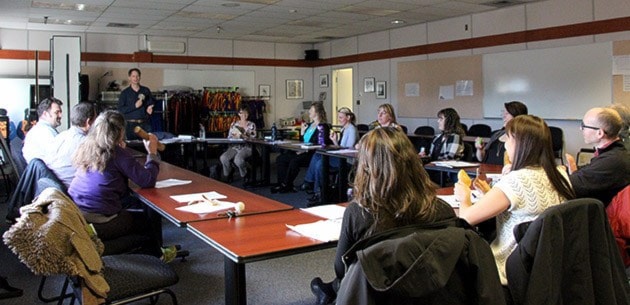Vanderhoof’s mental health support team is revisiting protocols and communication tools to help overcome current service difficulties in town.
On March 9, fourteen regional and local service providers, school representatives, and members of the local action team for a province-wide Shared Care initiative discussed youth mental health support in Vanderhoof at W. L. McLeod Elementary.
For the first time, healers trained in traditional therapeutic methods such as Reiki, a Japanese technique for stress reduction and relaxation, were also invited into the discussion to be part of the collaborative.
All attending service providers echoed that currently available resources in the community are insufficient to handle the amount of mental health support needed, leading to long wait-lists and temporary solutions.
A youth support worker recounted that for some families, it’s the youth who are the motivators at home, “cooking and making their parents go to work,” she said.
“They don’t know where to go for help, and lots of services require a guardian,” she explained, adding that when parents are suffering from their own mental health or substance use issues, a responsible guardian is not always available.
For others, it may be boredom after school, leading them to drug and alcohol abuse, she added.
“They want someone who show that they care,” she said.
For Todd Blattner, School District No. 91 counsellor, fourteen kids may be scheduled for appointments with him on one day, though there is generally only time to see seven or eight.
“Many come into school without breakfast” he said, “And with sugary and starchy food for lunch, that is not very nutritious and this tends to make behaviour and emotional issues worse.
“Sometimes all we can do is to try to make one moment better.”
Danny Scoular, family services program manager of Nechako Valley Community Services Society stated that a mental health clinician may spend half their day of work travelling and jumping through system’s hoops with paperwork before they are able to spend meaningful time with youth.
“We keep seeing kids, but we need to see and work with families as well and we’re not always able to do that,” Scoular said. “More and more, we’re just putting out fires on each crisis, but the same crises emerge later on if we don’t have the time and resources to do preventative work.”
W. L. McLeod teacher Patty Borek suggested that teachers can be advised on strategies that can be used in the classroom to help struggling students.
For Ken Young, it’s moving to see the students who benefited from the help — a student who attended school once a week in the beginning is now graduating, for example.
Other service providers said that some organizations in the region struggle with high turnover rates — funding is available but it’s difficult to attract or retain workers. This means that children may have a string of many counsellors and service providers — an inconsistency that is counterproductive to therapy.
Part of the Child and Youth Mental Health and Substance Use Collaborative, an initiative of the Shared Care Committee formed by Doctors of BC and B.C.’s Ministry of Health, the local action team will look to address communication barriers and service delivery gaps by focusing on three main projects in 2016: crisis response protocols, a community resource website, and client journey mapping, explained project lead Jeremy Blattner. Each of these projects are small steps the collaborative is hoping will make it easier for families to access services.
The Journey mapping is a research project that will map the many steps an individual takes to get mental health support within the current health system. It will “illustrate how arduous it is for someone to go through the system and what changes need to be made,” Scoular said.
The website will serve as a hub, listing available resources and information on how to access local support. The format of the site will be user-friendly and youth-oriented.
Updating crisis response protocols will address coordination of critical services and information sharing to support youth and families in need.
Those interested in joining the Mental Health collaborative or getting more information on the work being done are advised to contact Jeremy Blattner at earthdim5@gmail.com.
